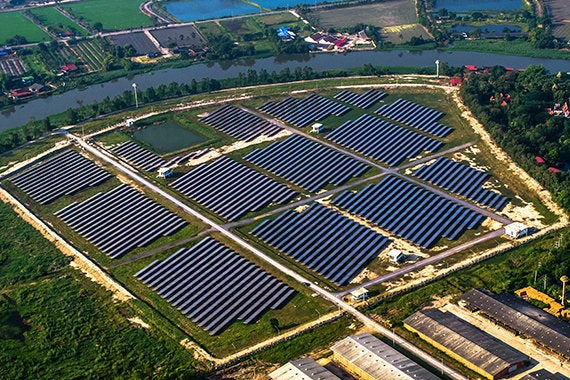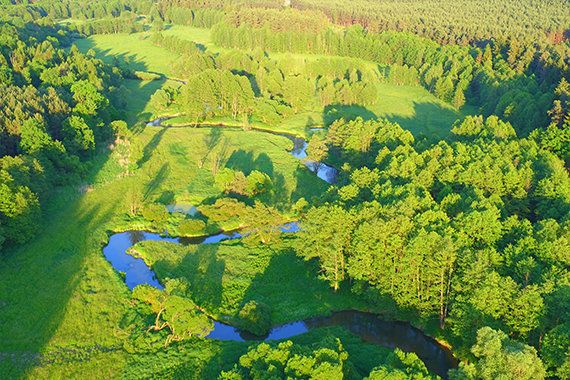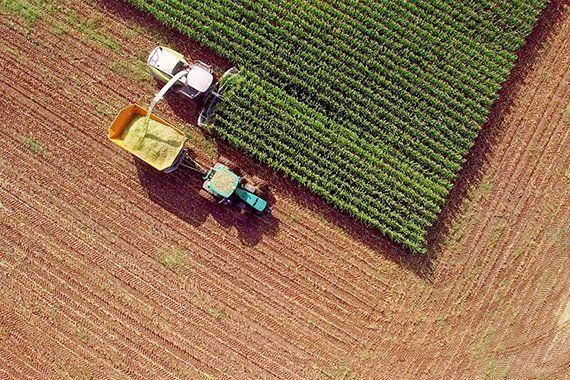A quick word association game: when you hear drone, what comes most quickly to mind? Chances are it’ll be strike, right? It certainly won’t be ecological or green or environmental.
And yet, despite its common association with the military, drones – or UAVs (Unmanned Aerial Vehicles) – are increasingly being used to sustain and improve the environment. They’re lightweight, low-cost, require little in the way of infrastructure and, crucially, use little or no fuel.

Sustaining sustainable energy
One of the areas you’re most likely to find drones at work these days are on solar farms. Solar farms can cover anything from one to one hundred acres, and maintaining them manually can be both impractical and dangerous, especially as engineers often want to inspect panels for defects when the sun is at its most powerful.
But companies like the French UAV operator Dronotec have fitted drones with thermal imaging cameras which provide an aerial overview to pin-point panels that might be damaged, covered in dust or obscured by invasive vegetation. Engineers then process this information and return to these specific locations to fix the panels at convenient times, making for more efficient maintenance.
Another sustainable industry that benefits enormously from drone technology are wind farms. Traditionally, inspections involve hooking people up to wires and hanging them off the structure, but companies like the UK’s Cyberhawk use drones to send back real-time video of power cables and 3D images of turbine blades. Only when faults are discovered do engineers need to ready their ropes and slings.
A mission on emissions
Just as drones are being used to support sustainable energy, they’re also being adapted to monitor pollution. One start-up in Finland called Aeromon is able to detect and analyse 70 different industrial emissions and map air quality over large areas. In the past, these emissions might have gone undetected because emissions sensors at ground level or higher altitudes would have missed them, but the versatility of UAVs means that’s no longer the case, and the data provided gives authorities more clout when it comes to enforcing emissions legislation.
This kind of use for drones is also happening elsewhere. They are being deployed to monitor methane at landfills in the UK, ship emissions in European waters and gas leaks in the US. Similarly, drones are also increasingly being modified to detect contaminated water, such as the MIT project called the Waterfly which looks for deadly cyanobacteria in water and can be deployed in remote, hard-to-reach areas.

Conservation
It’s precisely the drone’s ability to access difficult or problematic areas that’s proved most effective when it comes to conservation. Over savannah, a tropical rainforest or vast river-ways, drones can detect and monitor animal populations, deforestation and water levels. They can also spot poachers and alert their whereabouts to the police, or observe where illegal logging might be occurring.
They have already been used to great effect to protect whales from illegal hunting thanks to the Sea Shepherd Conservation Society, while the similarly named Air Shepherd flies drones at night to stop poachers killing rhinos and elephants for their ivory. And in the future drones may even be able to help restore the natural habitat of wildlife. A company called BioCarbon Engineering has designed a drone that quickly and efficiently plants trees by using a tiny cannon to shoot pods at the ground containing germinated seeds.
Disaster watch
Concerns with environmental conservation are closely linked to those of environmental disaster, and drones are in action here too. The Lamont Doherty Earth Observatory monitors ice melt in the Artic, using drones to get to awkward places. Equipped with infrared cameras, the drones collect data on temperature changes and meltwater. At the other end of the scale, drones have proved useful in tracking lava flows, as well as detecting and limiting forest fires. When Typhoon Haiyan struck the Philippines back in 2013, they were used to assess damage and plan shelter reconstruction, and they are also employed to drop urgent medical supplies to remote areas more quickly than could be done any other way.

Farming drones
Finally, drones are hard at work down on the farm. They specialise in crop spraying, UAVs being able to apply fertilisers more accurately than planes and thus reduce waste by 20 percent. They are also ideal for monitoring the health of crops, the whereabouts of livestock and the condition of water levels, all of which helps to improve yield and provide cost efficiency.
Farmers are also using them to map terrain to assess the land. A research team in Moscow did just that for a wheat fertilization project resulting in a 20 percent reduction in the amount of nitrogen released into the environment. There are even some examples of drones replacing the work of the traditional sheepdog, although this is one area where we think a line should be drawn!
All in all, with drones taking on new and environmentally-positive roles all the time, it won’t be long before we think of them not as a destructive technology, but one that has become essential to the well-being of the planet.